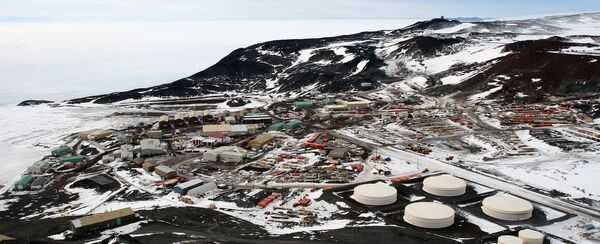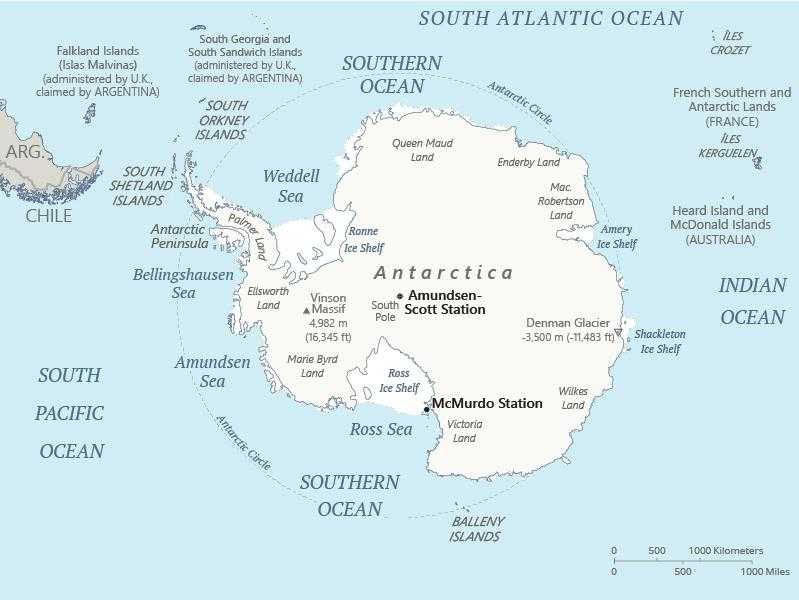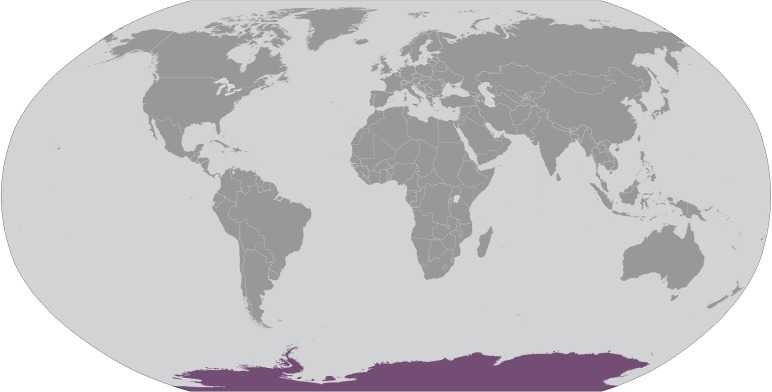Introduction
Background
Speculation over the existence of a "southern land" was confirmed in the early 1820s when British and American commercial operators and British and Russian national expeditions began exploring the Antarctic Peninsula region and other areas south of the Antarctic Circle. In 1840, it was finally established that Antarctica was indeed a continent and not merely a group of islands or an area of ocean. Several exploration "firsts" were achieved in the early 20th century, but the area saw little human activity. Following World War II, however, the continent experienced an upsurge in scientific research. A number of countries have set up a range of year-round and seasonal stations, camps, and refuges to support scientific research in Antarctica. Seven have made territorial claims, with two maintaining the basis for a claim, but most countries do not recognize these claims. In order to form a legal framework for countries' activities on the continent, an Antarctic Treaty was negotiated that neither denies nor recognizes existing territorial claims; it was signed in 1959 and entered into force in 1961. Also relevant to Antarctic governance are the Environmental Protocol to the Antarctic Treaty and the Convention on the Conservation of Antarctic Marine Living Resources.
Visit the Definitions and Notes page to view a description of each topic.
Geography
Location
continent mostly south of the Antarctic Circle
Geographic coordinates
90 00 S, 0 00 E
Map references
Antarctic Region
Area
total : 14.2 million sq km
land: 14.2 million sq km (285,000 sq km ice-free, 13.915 million sq km ice-covered) (est.)
note: fifth-largest continent, following Asia, Africa, North America, and South America, but larger than Australia and the subcontinent of Europe
comparison ranking: total 2
Area - comparative
slightly less than 1.5 times the size of the US
Land boundaries
note: see entry on Disputes - international
Coastline
17,968 km
Maritime claims
Australia, Chile, and Argentina claim Exclusive Economic Zone (EEZ) rights or similar over 200 nm extensions seaward from their continental claims, but like the claims themselves, these zones are not accepted by other countries; 22 of 29 Antarctic Treaty consultative parties have made no claims to Antarctic territory, although Russia and the United States have reserved the right to do so, and no country can make a new claim; also see the Disputes - international entry
Climate
the coldest, windiest, and driest continent on Earth; severe low temperatures vary with latitude, elevation, and distance from the ocean; East Antarctica is colder than West Antarctica because of its higher elevation; Antarctic Peninsula has the most moderate climate; higher temperatures occur in January along the coast and average slightly below freezing; summers characterized by continuous daylight, while winters bring continuous darkness; persistent high pressure over the interior brings dry, subsiding air that results in very little cloud cover
Terrain
about 99% thick continental ice sheet and 1% barren rock, with average elevations between 2,000 and 4,000 m; mountain ranges up to nearly 5,000 m; ice-free coastal areas include parts of southern Victoria Land, Wilkes Land, the Antarctic Peninsula area, and parts of Ross Island on McMurdo Sound; glaciers form ice shelves along about half of the coastline, and floating ice shelves constitute 11% of the area of the continent
Elevation
highest point: Vinson Massif 4,892 m
lowest point: Denman Glacier more than -3,500 m (-11,500 ft) below sea level
mean elevation: 2,300 m
note: the lowest known land point in Antarctica is hidden in the Denman Glacier; at its surface is the deepest ice yet discovered and the world's lowest elevation not under seawater
Natural resources
iron ore, chromium, copper, gold, nickel, platinum and other minerals, and coal and hydrocarbons have been found in small noncommercial quantities; mineral exploitation except for scientific research is banned by the Environmental Protocol to the Antarctic Treaty; krill, icefish, toothfish, and crab have been taken by commercial fisheries, which are managed through the Commission for the Conservation of Antarctic Marine Living Resources (CCAMLR)
Land use
agricultural land: 0% (2018 est.)
Natural hazards
katabatic (gravity-driven) winds blow coastward from the high interior; frequent blizzards form near the foot of the plateau; cyclonic storms form over the ocean and move clockwise along the coast; large icebergs may calve from ice shelf
volcanism: volcanic activity on Deception Island and isolated areas of West Antarctica; other seismic activity rare and weak
Geography - note
the coldest, windiest, highest (on average), and driest continent; during summer, more solar radiation reaches the surface at the South Pole than is received at the Equator in an equivalent period
mostly uninhabitable, 99% of the land area is covered by the Antarctic ice sheet, the largest single mass of ice on earth covering an area of 14 million sq km (5.4 million sq mi) and containing 26.5 million cu km (6.4 million cu mi) of ice (this is almost 62% of all of the world's fresh water); if all this ice were converted to liquid water, one estimate is that it would be sufficient to raise the height of the world's oceans by 58 m (190 ft)
People and Society
Population
no indigenous inhabitants, but staff is present at year-round and summer-only research stations
note: 56 countries have signed the 1959 Antarctic Treaty; 30 of those operate through their National Antarctic Program a number of seasonal-only (summer) and year-round research stations on the continent and its nearby islands south of 60 degrees south latitude (the region covered by the Antarctic Treaty); the population engaging in and supporting science or managing and protecting the Antarctic region varies from approximately 5,000 in summer to 1,100 in winter; in addition, approximately 1,000 personnel, including ship's crew and scientists doing onboard research, are present in the waters of the treaty region
as of 2024, peak summer (December-February) maximum capacity in scientific stations - 4,713 total; Argentina 425, Australia 238, Belarus 15, Belgium 55, Brazil 64, Bulgaria 25, Chile 375, China 164, Czechia 32, Ecuador 35, Finland 16, France 136, France and Italy jointly 70, Germany 60, India 72, Italy 150, Japan 130, South Korea 158, New Zealand 85, Norway 60, Peru 30, Poland 41, Russia 211, South Africa 80, Spain 79, Sweden 16, Ukraine 15, United Kingdom 315, United States 1,495 , Uruguay 66 (2024)
winter (June-August) maximum capacity in scientific stations - 1,056 total; Argentina 221, Australia 52, Brazil 15, Chile 114, China 32, France 24, France and Italy jointly 13, Germany 9, India 48, Japan 40, Netherlands 10, South Korea 25, NZ 11, Norway 7, Poland 16, Russia 125, South Africa 15, Ukraine 12, UK 44, US 215, Uruguay 8 (2024)
in addition, during the austral summer, some nations have numerous occupied locations such as tent camps, summer-long temporary facilities, and mobile traverses in support of research
Environment
Environment - current issues
the discovery of a large Antarctic ozone hole in the earth's stratosphere (the ozone layer) - first announced in 1985 - spurred the signing of the Montreal Protocol in 1987, an international agreement phasing out the use of ozone-depleting chemicals; the ozone layer prevents most harmful wavelengths of ultra-violet (UV) light from passing through the earth's atmosphere; ozone depletion has been shown to harm a variety of Antarctic marine plants and animals (plankton); in 2016, a gradual trend toward "healing" of the ozone hole was reported; since the 1990s, satellites have shown accelerating ice loss driven by ocean change; although considerable uncertainty remains, scientists are increasing our understanding and ability to model potential impacts of ice loss
Climate
the coldest, windiest, and driest continent on Earth; severe low temperatures vary with latitude, elevation, and distance from the ocean; East Antarctica is colder than West Antarctica because of its higher elevation; Antarctic Peninsula has the most moderate climate; higher temperatures occur in January along the coast and average slightly below freezing; summers characterized by continuous daylight, while winters bring continuous darkness; persistent high pressure over the interior brings dry, subsiding air that results in very little cloud cover
Land use
agricultural land: 0% (2018 est.)
Government
Country name
conventional long form: none
conventional short form: Antarctica
etymology: name derived from two Greek words meaning "opposite to the Arctic" or "opposite to the north"
Government type
Antarctic Treaty Summary - the Antarctic region is governed by a system known as the Antarctic Treaty system; the system includes: 1. the Antarctic Treaty, signed on 1 December 1959 and entered into force on 23 June 1961, which establishes the legal framework for the management of Antarctica, 2. Measures, Decisions, and Resolutions adopted at Antarctic Treaty Consultative Meetings, 3. The Convention for the Conservation of Antarctic Seals (1972), 4. The Convention on the Conservation of Antarctic Marine Living Resources (1980), and 5. The Protocol on Environmental Protection to the Antarctic Treaty (1991); the Antarctic Treaty Consultative Meetings operate by consensus (not by vote) of all consultative parties at annual Treaty meetings; by January 2024, there were 56 treaty member nations: 29 consultative and 27 non-consultative; consultative (decision-making) members include the seven nations that claim portions of Antarctica as national territory (some claims overlap) and 22 non-claimant nations; the US and Russia have reserved the right to make claims; the US does not recognize the claims of others; Antarctica is administered through meetings of the consultative member nations; measures adopted at these meetings are carried out by these member nations (with respect to their own nationals and operations) in accordance with their own national laws; the years in parentheses indicate when a consultative member-nation acceded to the Treaty and when it was accepted as a consultative member, while no date indicates the country was an original 1959 treaty signatory; claimant nations are - Argentina, Australia, Chile, France, NZ, Norway, and the UK; nonclaimant consultative nations are - Belgium, Brazil (1975/1983), Bulgaria (1978/1998), China (1983/1985), Czechia (1962/2014), Ecuador (1987/1990), Finland (1984/1989), Germany (1979/1981), India (1983/1983), Italy (1981/1987), Japan, South Korea (1986/1989), Netherlands (1967/1990), Peru (1981/1989), Poland (1961/1977), Russia, South Africa, Spain (1982/1988), Sweden (1984/1988), Ukraine (1992/2004), Uruguay (1980/1985), and the US; non-consultative members, with year of accession in parentheses, are - Austria (1987), Belarus (2006), Canada (1988), Colombia (1989), Costa Rica (2022) Cuba (1984), Denmark (1965), Estonia (2001), Greece (1987), Guatemala (1991), Hungary (1984), Iceland (2015), Kazakhstan (2015), North Korea (1987), Malaysia (2011), Monaco (2008), Mongolia (2015), Pakistan (2012), Papua New Guinea (1981), Portugal (2010), Romania (1971), San Marino (2023), Slovakia (1962/1993), Slovenia (2019), Switzerland (1990), Turkey (1996), and Venezuela (1999); note - Czechoslovakia acceded to the Treaty in 1962 and separated into the Czech Republic and Slovakia in 1993; Article 1 - area to be used for peaceful purposes only; military activity, such as weapons testing, is prohibited, but military personnel and equipment may be used for scientific research or any other peaceful purpose; Article 2 - freedom of scientific investigation and cooperation shall continue; Article 3 - free exchange of information and personnel, cooperation with the UN and other international agencies; Article 4 - does not recognize, dispute, or establish territorial claims and no new claims shall be asserted while the treaty is in force; Article 5 - prohibits nuclear explosions or disposal of radioactive wastes; Article 6 - includes under the treaty all land and ice shelves south of 60 degrees 00 minutes south and reserves high seas rights; Article 7 - treaty-state observers have free access, including aerial observation, to any area and may inspect all stations, installations, and equipment; advance notice of all expeditions and of the introduction of military personnel must be given; Article 8 - allows for jurisdiction over observers and scientists by their own states; Article 9 - frequent consultative meetings take place among member nations; Article 10 - treaty states will discourage activities by any country in Antarctica that are contrary to the treaty; Article 11 - disputes to be settled peacefully by the parties concerned or, ultimately, by the International Court of Justice; Articles 12, 13, 14 - deal with upholding, interpreting, and amending the treaty among involved nations; other agreements - some 200 measures adopted at treaty consultative meetings and approved by governments; the Protocol on Environmental Protection to the Antarctic Treaty was signed 4 October 1991 and entered into force 14 January 1998; this agreement provides for the protection of the Antarctic environment and includes five annexes that have entered into force: 1) environmental impact assessment, 2) conservation of Antarctic fauna and flora, 3) waste disposal and waste management, 4) prevention of marine pollution, 5) area protection and management; a sixth annex addressing liability arising from environmental emergencies has yet to enter into force; the Protocol prohibits all activities relating to mineral resources except scientific research; a permanent Antarctic Treaty Secretariat was established in 2004 in Buenos Aires, Argentina
Legal system
Antarctica is administered through annual meetings - known as Antarctic Treaty Consultative Meetings - which include consultative member nations, non-consultative member nations, observer organizations, and expert organizations; decisions from these meetings are carried out by these member nations (with respect to their own nationals and operations) in accordance with their own national laws; more generally, the Antarctic Treaty area and all areas south of 60 degrees south latitude, including all ice shelves and islands, are subject to a number of relevant legal instruments and procedures adopted by the states party to the Antarctic Treaty; note - US law, including certain criminal offenses by or against US nationals, such as murder, may apply extraterritoriality; some US laws directly apply to Antarctica; for example, the Antarctic Conservation Act, 16 U.S.C. section 2401 et seq., provides civil and criminal penalties for the following activities unless authorized by regulation or statute: the taking of native mammals or birds; the introduction of nonindigenous plants and animals; entry into specially protected areas; the discharge or disposal of pollutants; and the importation into the US of certain items from Antarctica; violation of the Antarctic Conservation Act carries penalties of up to $10,000 in fines and one year in prison; the National Science Foundation and Department of Justice share enforcement responsibilities; Public Law 95-541, the US Antarctic Conservation Act of 1978, as amended in 1996, requires expeditions from the US to Antarctica to notify, in advance, the Office of Ocean and Polar Affairs, Room 2665, Department of State, Washington, DC 20520, which reports such plans to other nations as required by the Antarctic Treaty; for more information, contact antarctica@state.gov
Flag description
unofficial; a True South flag, created in 2018, has quickly become popular for its simple yet elegant design and has been used by various National Antarctic Programs, Antarctic nonprofits, and expedition teams; the flag's meaning is described as horizontal stripes of navy and white representing the long days and nights at Antarctica's extreme latitude, with a lone white peak erupting from a field of snow and ice at the center; the long shadow it casts forms the shape of a compass arrow pointed south, an homage to the continent's legacy of exploration; together, the two center shapes create a diamond, symbolizing the hope that Antarctica will continue to be a center of peace, discovery, and cooperation for generations to come
Energy
Petroleum
refined petroleum consumption: 79.9 bbl/day (2022 est.)
Carbon dioxide emissions
12,000 metric tonnes of CO2 (2022 est.)
from petroleum and other liquids: 12,000 metric tonnes of CO2 (2022 est.)
comparison ranking: total emissions 216
Communications
Telecommunication systems
general assessment:
general assessment: scientists with the United States Antarctic Program at McMurdo Station have a designated Starlink terminal, which has improved connectivity to carry out research; this was made possible through laser links between the SpaceX satellites in orbit that eliminate the need for ground stations at the poles, and makes Antarctica the seventh and final continent to receive Starlink internet coverage (2022)
(2022)domestic: commercial cellular networks operating in a small number of locations (2019)
international: country code - none allocated; via satellite (including mobile Inmarsat and Iridium systems) to and from all research stations, ships, aircraft, and most field parties
Internet users
total: 4,400 (2021 est.)
percent of population: 100% (2021 est.)
comparison ranking: total 224
Transportation
Heliports
5 (2024)
Ports
total ports: 8 (2024)
large: 0
medium: 0
small: 1
very small: 7
ports with oil terminals: 0
key ports: Admiralty Bay, Andersen Harbor, Ellefsen Harbor, McMurdo Station, Melchior Harbor, Port Foster, Port Lockroy, Scotia Bay
Transportation - note
US coastal stations include McMurdo (77 51 S, 166 40 E) and Palmer (64 43 S, 64 03 W); government use only; all ships are subject to inspection in accordance with Article 7 of the Antarctic Treaty; ships must comply with relevant legal instruments and authorization procedures under the Antarctic Treaty (see "Legal System"); The Hydrographic Commission on Antarctica (HCA), a commission of the International Hydrographic Organization (IHO), coordinates and facilitates provision of accurate and appropriate charts and other aids to navigation; membership in HCA is open to any IHO Member State whose government has acceded to the Antarctic Treaty and which contributes resources or data to IHO Chart coverage of the area
Military and Security
Military - note
the Antarctic Treaty of 1961 prohibits any measures of a military nature, such as the establishment of military bases and fortifications, the carrying out of military maneuvers, or the testing of any type of weapon; it permits the use of military personnel or equipment for scientific research or for any other peaceful purposes



